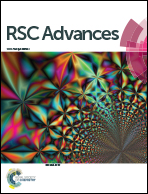Enhanced visible light photocatalytic activity in BiOCl/SnO2: heterojunction of two wide band-gap semiconductors†
Abstract
A series of BiOCl/SnO2 heterojunctions exhibiting exceptional visible light photocatalytic performance have been successfully prepared using a two-step solution route. The physical and chemical properties of the as-prepared samples were characterized by a range of techniques, including X-ray diffraction (XRD), transmission electron microscopy (TEM) and high-resolution TEM (HRTEM), energy dispersive spectroscopy (EDS), X-ray photoelectron spectroscopy (XPS), UV-vis diffuse reflectance spectroscopy (DRS), Brunauer–Emmett–Teller (BET), photoluminescence spectroscopy (PL), Mott–Schottcky measurement and surface photovoltage spectroscopy (SPS). It's found that SnO2 nanoparticles with average particle size of ∼4 nm were uniformly dispersed on the {110} facets of BiOCl nanosheets and a heterojunction was formed at the interface between SnO2 and BiOCl. A defect state referenced to oxygen vacancies and  vacancy associates play a vital role in reducing the band gap energy of SnO2 and BiOCl, respectively. With well-defined defect chemistry and heterostructure, the conjunction of two wide band-gap semiconductors (SnO2 and BiOCl) may lead to visible light harvesting and enhanced photocatalytic performance. The photocatalytic activities of the BiOCl/SnO2 heterojunction photocatalysts were evaluated by measuring the degradation of rhodamine B (RhB) under visible light irradiation. As was expected, the BiOCl/SnO2 composites displayed highly enhanced photocatalytic activity in comparison to the individual counterpart. The PL and SPS spectra confirmed that the formation of a p–n heterojunction between BiOCl and SnO2 can markedly accelerate the separation rate and inhibit the recombination of photo-induced electro–hole pairs, thus promoting the photocatalytic activity. As a consequence of well-modulated electronic structures, defect centers and heterostructure, the photocatalytic performance of BiOCl/SnO2 heterojunctions was well regulated and optimized.
vacancy associates play a vital role in reducing the band gap energy of SnO2 and BiOCl, respectively. With well-defined defect chemistry and heterostructure, the conjunction of two wide band-gap semiconductors (SnO2 and BiOCl) may lead to visible light harvesting and enhanced photocatalytic performance. The photocatalytic activities of the BiOCl/SnO2 heterojunction photocatalysts were evaluated by measuring the degradation of rhodamine B (RhB) under visible light irradiation. As was expected, the BiOCl/SnO2 composites displayed highly enhanced photocatalytic activity in comparison to the individual counterpart. The PL and SPS spectra confirmed that the formation of a p–n heterojunction between BiOCl and SnO2 can markedly accelerate the separation rate and inhibit the recombination of photo-induced electro–hole pairs, thus promoting the photocatalytic activity. As a consequence of well-modulated electronic structures, defect centers and heterostructure, the photocatalytic performance of BiOCl/SnO2 heterojunctions was well regulated and optimized.


 Please wait while we load your content...
Please wait while we load your content...